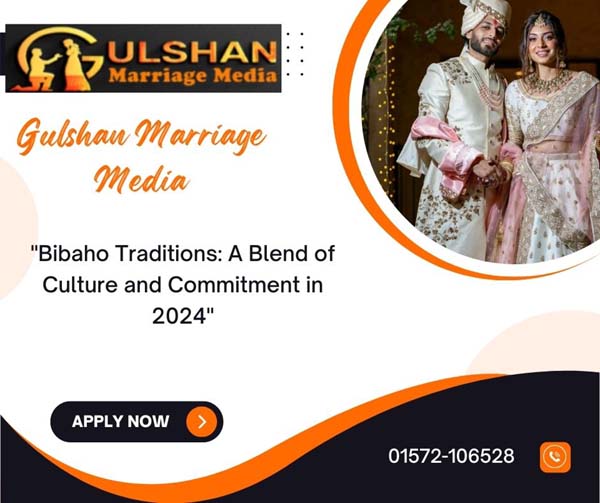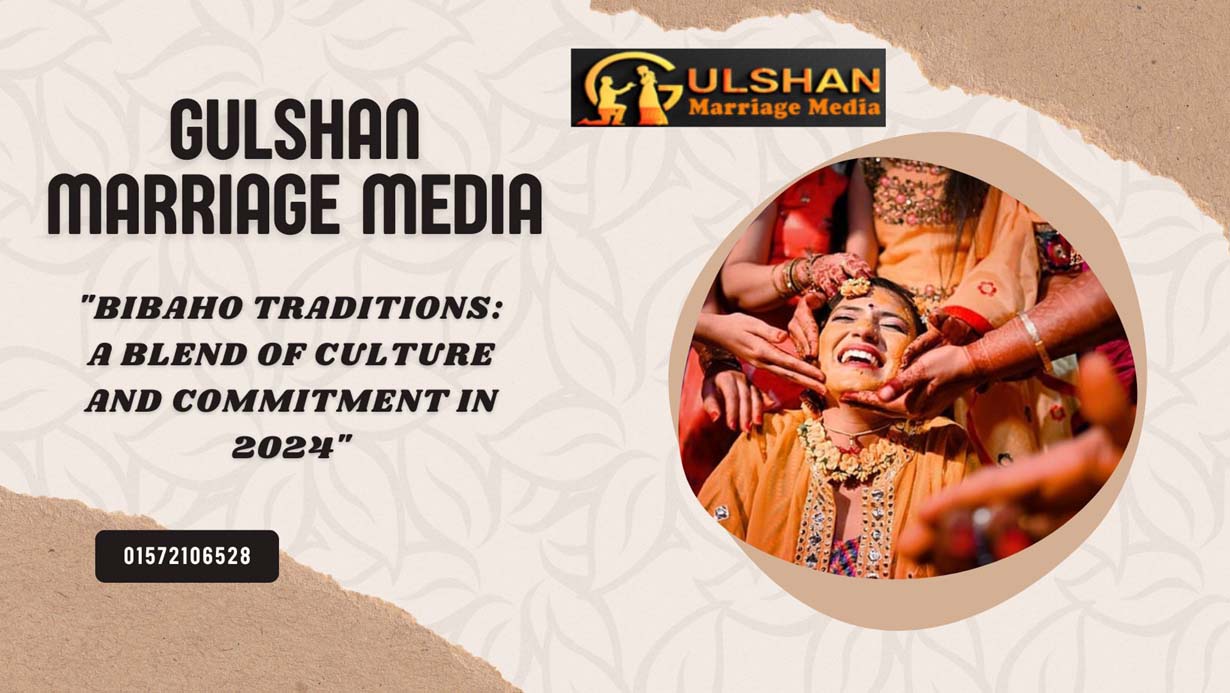“Bibaho Traditions: A Blend of Culture and Commitment in 2024”
Introduction
Marriage, or Bibaho, is more than just a union between two individuals; it is a profound celebration of culture, tradition, and lifelong commitment. Across generations and regions, Bibaho has served as a cornerstone of society, embodying the values, beliefs, and customs that define a community’s identity. From the intricate rituals to the heartfelt promises exchanged, every aspect of nuptial ceremony reflects the rich tapestry of heritage and the deep sense of duty that binds families and individuals together.
In this exploration of nuptial ceremony traditions, we delve into the fascinating ways in which culture and commitment intertwine to shape this sacred institution. By examining the historical roots, symbolic practices, and modern adaptations of Bibaho, we uncover how this timeless tradition continues to evolve while preserving its core essence—a harmonious blend of cultural pride and the promise of enduring devotion.
Historical Perspective of Bibaho Traditions
The roots of Bibaho can be traced back to ancient times when marriage was not only a personal milestone but also a social and economic necessity. In many cultures, marriage served as a means of building alliances, preserving lineage, and ensuring the continuation of traditions. These early unions were often shaped by religious doctrines, local customs, and the socio-political structures of their time.
In South Asia, for instance, the concept of Bibaho has been deeply influenced by Hindu, Muslim, Buddhist, and Christian traditions. Hindu marriages often emphasized the spiritual union of souls, represented through rituals like the Saptapadi (seven steps around the sacred fire). Muslim marriages centered on the Nikah ceremony, a contract symbolizing mutual consent and commitment. Buddhist and Christian weddings brought their unique customs and symbols, each reflecting the cultural and spiritual ethos of their communities.
Over time, these traditions evolved, blending elements from different regions and communities. The British colonial era introduced Western influences, such as white wedding gowns and formal ceremonies, while globalization in modern times has brought about a fusion of traditional and contemporary practices. Despite these changes, the essence of Bibaho remains rooted in its dual purpose: honoring cultural heritage and fostering a lifelong commitment between partners.
This rich historical tapestry underscores the resilience and adaptability of Bibaho traditions, paving the way for a deeper understanding of the rituals and values that make them so enduring. In the following sections, we will explore the key elements of these traditions, their regional diversity, and their modern interpretations.
Key Elements of Bibaho Traditions

Marriage traditions are a harmonious blend of rituals and ceremonies, each carrying deep symbolic meaning. These elements are carefully woven into the fabric of marriage, creating a rich, multi-layered experience that celebrates both cultural heritage and the union of two souls.
-
Pre-Marriage Customs
The journey of wedding begins long before the wedding day, with a series of pre-marriage customs that set the stage for the union.
-
Matchmaking and Proposal:
Traditionally, families play a pivotal role in arranging marriages, ensuring compatibility based on social, cultural, and astrological considerations. In modern times, online matchmaking platforms and love marriages are also gaining popularity.
-
Engagement Ceremonies:
The engagement, often marked by an exchange of rings or gifts, signifies the formal agreement between families and couples. It is a moment of joy and anticipation, where loved ones come together to celebrate the beginning of a new chapter.
-
Marriage Rituals
The heart of wedding lies in its wedding day ceremonies, which are steeped in tradition and symbolic significance.
-
Gaye Holud (Turmeric Ceremony):
A vibrant pre-wedding ritual in Bengali and South Asian cultures, turmeric paste is applied to the bride and groom to bless them with prosperity and glowing health.
-
Mehendi (Henna Ceremony):
Intricate henna designs are drawn on the bride’s hands and feet, popular in South Asian weddings. These designs symbolize beauty, joy, and the couple’s bond.
-
Main Wedding Ceremony:
The main event varies across cultures—Hindu weddings feature the sacred Saptapadi, where the couple takes seven vows around a fire. In contrast, Muslim weddings focus on the Nikah, a contractual agreement witnessed by family and friends. Each ritual highlights values like trust, respect, and mutual commitment.
-
Post-Marriage Practices
- Welcoming the Bride/Groom:
In many cultures, the bride is ceremoniously welcomed into the groom’s home, symbolizing her integration into the new family. In some traditions, playful customs, such as stealing the groom’s shoes, add a light-hearted touch to the occasion. - Starting a New Life:
Post-marriage rituals often focus on blessings for prosperity, harmony, and fertility. These traditions emphasize the importance of mutual support and the couple’s role in building a strong foundation for their future.
These key elements of Bibaho traditions showcase the beauty and depth of cultural practices that celebrate love, unity, and commitment. In the next section, we will explore how regional and community differences contribute to the diversity of these timeless customs.
Cultural Diversity in Bibaho Traditions
One of the most fascinating aspects of wedding is its diversity across regions and communities. While the core idea of marriage as a union of love and commitment remains consistent, the rituals, customs, and symbolism vary widely, reflecting the rich cultural tapestry of different societies.
-
Regional Variations in Bibaho Traditions
Each region has its unique take on marriage traditions, blending local customs with universal values.
- Bangladeshi Weddings:
Traditional Bangladeshi weddings are known for their vibrant Gaye Holud ceremonies, elaborate bridal attire, and festive receptions (Walima). The Nikah is central to Islamic weddings, where the couple signs a contract signifying their mutual consent and responsibilities. - Indian Weddings:
In India, the diversity is astounding, from North Indian Hindu weddings with the Saat Phere (seven sacred rounds) to South Indian ceremonies featuring the tying of the Mangalsutra (sacred thread). Sikh weddings include the Anand Karaj (blissful union), while Christian ceremonies feature blessings and vows exchanged in a church. - Pakistani Weddings:
Pakistani weddings emphasize traditional Islamic practices, with pre-wedding events like Dholki (music night) and post-wedding receptions. The Nikah and Rukhsati (bride’s departure) are key moments, symbolizing the union and transition. - Nepali Weddings:
In Nepal, both Hindu and Buddhist traditions influence weddings, with rituals like Sindoor Daan (application of vermillion) and the use of sacred rice in blessings. The colorful, joyous events reflect the mountainous nation’s spiritual and cultural richness.
-
Unique Practices Reflecting Cultural Identities
- Bengali Weddings:
Distinctive features include the bride’s traditional Saree draped in red and white, and the groom’s Topor (ceremonial headgear). The couple often sits on a Piri (wooden plank) carried by family members during the wedding rituals. - Tribal and Indigenous Communities:
Tribal communities across South Asia have unique customs, such as symbolic dances, offerings to nature, and storytelling traditions that emphasize communal bonds. - Cross-Cultural Marriages:
As globalization and multicultural interactions increase, cross-cultural marriages have introduced creative blends of traditions. Couples often incorporate elements from both cultures, resulting in unique and inclusive celebrations.
-
Common Threads Across Cultures
Despite regional and cultural differences, wedding traditions share universal themes of love, unity, and commitment. The presence of family, blessings from elders, and rituals symbolizing shared responsibility are central to almost all ceremonies.
This diversity within Wedding traditions highlights the adaptability and inclusiveness of marriage as a social and cultural institution. In the next section, we will discuss how modern influences are reshaping these traditional practices while maintaining their essence.
Modern Influences on Traditional Bibaho
As societies evolve, so do the customs and traditions that define them. Bibaho, while deeply rooted in cultural heritage, has not remained untouched by the forces of modernization, globalization, and technological advancements. Today, traditional practices coexist with contemporary trends, reflecting a blend of old and new.
-
Impact of Globalization on Bibaho Traditions
Globalization has brought exposure to diverse cultures, leading to the incorporation of international elements into traditional weddings.
- Fusion Weddings:
Couples from different cultural backgrounds often combine traditions, creating unique ceremonies that honor both heritages. For example, a South Asian wedding might include Western-style vows alongside traditional rituals. - Global Trends in Fashion and Décor:
The influence of global fashion has led to more varied bridal attire, with brides and grooms opting for gowns, tuxedos, or designer fusion wear alongside traditional garments. Wedding décor has also evolved, featuring themes inspired by global aesthetics.
-
The Role of Technology in Bibaho
Technology has significantly transformed how marriages are planned, celebrated, and even initiated.
- Online Matchmaking Services:
Traditional matchmakers have given way to digital platforms that connect individuals across the globe. These platforms offer personalized matchmaking based on shared values and preferences, making the process more efficient. - Virtual Ceremonies:
In the wake of global events like the COVID-19 pandemic, virtual weddings have gained popularity. Couples now livestream their ceremonies, enabling family and friends from around the world to participate. - Social Media and Wedding Trends:
Social media platforms have influenced wedding planning, from sharing creative ideas for rituals to hosting hashtagged events. Couples often document their wedding journey through Instagram or YouTube, blending tradition with modern storytelling.
-
Shifting Roles and Expectations
Modern wedding reflects changing societal norms and expectations, especially regarding gender roles and individuality.
- Equality and Partnership:
Traditional roles within marriage are increasingly evolving to promote equality and mutual respect. Couples emphasize shared responsibilities and decision-making, aligning with modern values of partnership. - Personalized Ceremonies:
Weddings today often feature personalized touches, from writing one’s vows to incorporating hobbies or shared interests into the ceremony. These elements highlight the individuality of the couple while honoring tradition.
-
Balancing Tradition and Modernity
One of the key challenges of modern Marriage is striking a balance between preserving cultural heritage and embracing contemporary influences. Families and couples often navigate this balance by retaining core rituals while allowing flexibility in other aspects, such as attire, music, or venue selection.
Modern influences have added new dimensions to Marriage traditions, making them more inclusive, accessible, and reflective of individual values. However, the essence of Marriage—the celebration of love, family, and commitment—remains timeless. In the next section, we will delve into the symbolism of commitment within Marriage, exploring how these traditions emphasize enduring devotion.
Symbolism of Commitment in Bibaho
At its heart, Marriage is more than a ceremonial union—it is a profound expression of commitment, trust, and mutual respect. This commitment is symbolized through various rituals, customs, and objects that serve as tangible representations of the promises made between the couple. These symbols transcend time, reflecting the enduring values that Biye seeks to uphold.
-
Sacred Rituals Representing Commitment
- Exchanging Vows:
In many cultures, the exchange of vows or promises is central to Bibaho. Whether spoken aloud or implied through rituals, these vows signify the couple’s intention to support and cherish one another through all phases of life. - Binding Ceremonies:
Rituals such as tying knots (e.g., Mangalsutra in Hindu weddings) or signing the Nikah contract in Muslim weddings symbolize the formal bond between partners. These acts serve as a public declaration of their shared responsibilities and enduring partnership. - Sacred Fires and Circles:
In Hindu weddings, the couple circles the sacred fire during the Saptapadi, signifying their journey together as equals. The fire serves as a witness to their union, representing purity and the eternal nature of their commitment.
-
Symbolic Objects and Attire
- Rings and Ornaments:
Exchanging rings, a tradition widely adopted in Marriage ceremonies, signifies eternal love and unity. In South Asian cultures, ornaments such as bangles, anklets, or the Sindoor (vermilion) mark the marital status and commitment of the couple. - Clothing as a Symbol:
The attire worn during Bibaho is often imbued with symbolic meaning. For example, the bride’s red sari in Bengali weddings represents prosperity and fertility, while the groom’s traditional attire reflects cultural pride and respect for tradition.
-
Community and Family as Symbols of Support
The involvement of family and community is a cornerstone of Marriage, symbolizing the collective commitment to support the couple in their journey. Rituals often involve blessings from elders, the exchange of gifts, and group celebrations, highlighting the importance of social bonds in a marriage.
-
Shared Meals and Unity
In many traditions, the couple shares a meal as part of the wedding rituals. This act symbolizes their commitment to nurturing each other and their household. For example, in Bengali weddings, the Bashor Bhat (wedding feast) signifies the beginning of their shared life.
-
Stories of Enduring Commitment
Marriage traditions are often accompanied by tales of legendary couples whose love and dedication inspire new unions. These stories serve as a reminder of the resilience and devotion required to sustain a lifelong partnership.
The symbolism of commitment in Bibaho extends beyond the wedding day, influencing the couple’s life together. Through rituals, objects, and shared values, Bibaho emphasizes the sanctity of marriage and the deep bond that unites two individuals. In the next section, we will explore the challenges and opportunities associated with maintaining these traditions in a rapidly changing world.
Challenges and Opportunities in Maintaining Traditions
As societies become increasingly dynamic, the preservation of traditional Marriage practices faces both challenges and opportunities. While modern influences have introduced flexibility and inclusivity, they have also raised concerns about the dilution of cultural heritage. Navigating these changes requires thoughtful engagement with both tradition and contemporary values.
-
Challenges in Maintaining Bibaho Traditions
- Cultural Dilution:
Globalization and modernization have sometimes led to a loss of traditional rituals, as simplified or hybrid ceremonies become more popular. For example, younger generations may prioritize convenience over intricate customs, leaving certain practices forgotten. - Economic Pressures:
The rising costs of elaborate weddings pose a challenge for many families. Social expectations around lavish ceremonies can overshadow the essence of Bibaho, making it more about display than tradition. - Generational Differences:
Younger generations often seek more autonomy in their marriage decisions, which can create friction with older family members who value traditional customs and matchmaking practices. - Time Constraints:
In fast-paced modern life, lengthy Marriage rituals are sometimes condensed or skipped altogether to accommodate busy schedules, leading to a loss of their deeper significance.
-
Opportunities to Revive and Adapt Traditions
- Cultural Revival Efforts:
Many families and communities are taking deliberate steps to revive and preserve traditional Marriage practices. Workshops, cultural events, and storytelling initiatives help pass these rituals to younger generations. - Inclusion in Modern Contexts:
By adapting traditions to align with contemporary values, couples can honor their heritage while embracing modern ideals. For instance, gender-equal practices, such as mutual vow exchanges, can replace outdated customs that might seem one-sided. - Eco-Friendly Weddings:
The rise of sustainable weddings offers an opportunity to blend traditional Bibaho elements with modern environmental consciousness. Simple yet meaningful ceremonies, local artisanal crafts, and organic foods can enhance the beauty of the wedding while reducing its ecological footprint.
-
Opportunities in Multicultural Marriages
- Cultural Exchange:
Cross-cultural marriages provide a platform for sharing and blending Marriage traditions with those from other cultures. These unions often celebrate diversity and promote understanding between different communities. - Creative Fusion Ceremonies:
Couples from diverse backgrounds are designing innovative weddings that reflect their unique identities. These ceremonies often incorporate symbolic elements from both cultures, making them deeply personal yet inclusive.
-
Role of Technology and Media
- Digital Preservation:
Technology can play a pivotal role in preserving Biye traditions. Digital archives, blogs, and video tutorials ensure that these customs are accessible to future generations. - Global Visibility:
Social media and online platforms provide opportunities to showcase traditional Marriage practices to a global audience, fostering appreciation and respect for cultural diversity.
-
Family and Community Support:
The active involvement of families and communities remains critical to the survival of Bibaha traditions. Celebrations that emphasize inclusivity and collaboration can bridge generational gaps and create meaningful connections.
While the challenges are real, the opportunities to innovate, adapt, and celebrate Bibaho traditions are abundant. By finding a balance between preserving the past and embracing the present, Marriage can continue to thrive as a vibrant expression of culture and commitment. In the concluding section, we will reflect on the enduring beauty of Marriage and its relevance in today’s world.
Conclusion
Bibaho, as a celebration of culture and commitment, stands as a testament to the enduring values that bind humanity across generations. Its rich tapestry of rituals and customs reflects the diversity and vibrancy of the communities that practice it, while its core essence—a union founded on love, trust, and mutual respect—remains universal.
In our exploration, we have seen how Marriage traditions have evolved over time, adapting to historical, regional, and modern influences. From intricate rituals and symbolic objects to the role of family and community, Bibaho encapsulates the beauty of human connection. Even as globalization and modernization reshape these traditions, their underlying values continue to inspire couples to honor their heritage while embracing the realities of contemporary life.
The challenges faced by Bibaho traditions, such as cultural dilution and economic pressures, also present opportunities for creativity, innovation, and revival. By blending the old with the new, couples and communities can ensure that Bibaho remains a living, evolving tradition. Whether through digital preservation, multicultural exchanges, or eco-conscious celebrations, the future of Bibaho is one of inclusivity and adaptability.
In essence, Bibaho is more than a series of ceremonies; it is a profound journey that reflects the harmonious blend of cultural pride and the promise of lifelong commitment. As the world changes, the spirit of Marriage endures, reminding us of the timeless beauty of love and the importance of honoring the traditions that shape our identities.


























